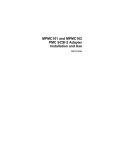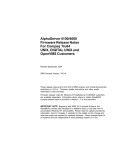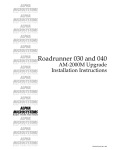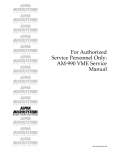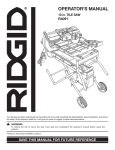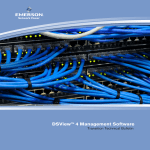Download Motorola MPMC101 User`s manual
Transcript
MPMC101 PMC SCSI-2 Adapter User’s Manual PMC101A/UM1 Notice While reasonable efforts have been made to assure the accuracy of this document, Motorola, Inc. assumes no liability resulting from any omissions in this document, or from the use of the information obtained therein. Motorola reserves the right to revise this document and to make changes from time to time in the content hereof without obligation of Motorola to notify any person of such revision or changes. No part of this material may be reproduced or copied in any tangible medium, or stored in a retrieval system, or transmitted in any form, or by any means, radio, electronic, mechanical, photocopying, recording or facsimile, or otherwise, without the prior written permission of Motorola, Inc. It is possible that this publication may contain reference to, or information about Motorola products (machines and programs), programming, or services that are not announced in your country. Such references or information must not be construed to mean that Motorola intends to announce such Motorola products, programming, or services in your country. Restricted Rights Legend If the documentation contained herein is supplied, directly or indirectly, to the U.S. Government, the following notice shall apply unless otherwise agreed to in writing by Motorola, Inc. Use, duplication, or disclosure by the Government is subject to restrictions as set forth in subparagraph (c)(1)(ii) of the Rights in Technical Data and Computer Software clause at DFARS 252.227-7013. Motorola, Inc. Computer Group 2900 South Diablo Way Tempe, Arizona 85282 Preface The information in this manual is adapted from the 4520/5520 PCI SCSI-2 Adapter UserÕs Guide, Interphase part number UG05520-000. This manual describes the PCI and PMC SCSI-2 adapters, the installation of the adapters into a motherboard, and the installation of the PCI software drivers. Please note that only the MPMC101 Single-ended PMC SCSI-2 Adapter is currently supported by Motorola. The terminology and structure of this manual are directed to system administrators, or those with equivalent technical experience. The manual is organized as follows: Chapter 1, Introduction, provides general information about the PCI SCSI-2 adapters, product features, and system requirements. Brief overviews for the PCI bus and the SCSI-2 architectures are provided at the end of the chapter. Chapter 2, Hardware Installation, provides step-by-step instructions for installing the PCI Adapter in a PCI bus-based user stations and servers. Installation of the PMC Adapter into motherboards that support a PMC mezzanine architecture is discussed in the latter sections of the chapter. Chapter 3, Software Driver Installation, provides a guide for conÞguring the AIX operating system, and step-by-step instructions for installing the PCI SCSI-2 Driver for the Windows NT operating systems. Chapter 4, Troubleshooting, provides tips and suggestions when having problems with the installation or with the operation of the adapters. Appendix A, SpeciÞcations, provides operating criteria and environmental limits for the adapters. Glossary, A collection of common acronyms and terms used in describing SCSI activity and functions. Related Documentation The NCR 53C8XX ProgrammerÕs Reference Guide (part number J109311) is referenced in this document. You may purchase this document by contacting your local Motorola sales ofÞce. Motorola¨ and the Motorola symbol are registered trademarks of Motorola, Inc. Interphase¨ is a registered trademark of Interphase Corporation, Inc. All other products mentioned in this document are trademarks or registered trademarks of their respective holders. © Copyright Motorola, Inc. 1995 All Rights Reserved Printed in the United States of America November 1995 Acronyms and Terminology The following acronyms and terminology are often used in this manual instead of the complete title or name: AEN CCB CCS CDB CPU DMA ISA LU LUN MIC PCI SCB SCSI Asynchronous Event Notification Command Control Block Command Control Set Command Descriptor Block Central Processing Unit Direct Memory Access Industry Standard Architecture Logical Unit Logical Unit Number Media Interface Connector Peripheral Component Interface SCSI Control Block Small Computer System Interconnect For extended deÞnitions of the above and other common computer and SCSI terms, please refer to the Glossary at the end of this UserÕs Guide. Conventions The following conventions are used in this manual. Computer-generated text is shown in typewriter font. Examples of computer-generated text are: program output (such as the screen display during the software installation procedure), commands, directory names, Þle names, variables, prompts, and sections of program code. Computer-generated text example Commands to be entered by the user are printed in bold courier type. For example: cd /usr/tmp Pressing the return key (↵ Return) at the end of the command line entry is assumed, when not explicitly shown. For example: /bin/su is the same as: /bin/su ↵ Return Input required by the user, when mixed with program output, is printed in bold courier type. References to UNIX programs and manual page entries follow the standard UNIX conventions. When a user command, system prompt, or a system response is too long to Þt on a single line in this userÕs guide it will be shown as Do you want the new kernel moved into \ vmunix?[y] with a backslash at the beginning of the continued lined or with a backslash at the end of the previous line. Safety Summary Safety Depends On You The following general safety precautions must be observed during all phases of operation, service, and repair of this equipment. Failure to comply with these precautions or with speciÞc warnings elsewhere in this manual violates safety standards of design, manufacture, and intended use of the equipment. Motorola, Inc. assumes no liability for the customer's failure to comply with these requirements. The safety precautions listed below represent warnings of certain dangers of which Motorola is aware. You, as the user of the product, should follow these warnings and all other safety precautions necessary for the safe operation of the equipment in your operating environment. Ground the Instrument. To minimize shock hazard, the equipment chassis and enclosure must be connected to an electrical ground. The equipment is supplied with a three-conductor ac power cable. The power cable must either be plugged into an approved three-contact electrical outlet or used with a three-contact to two-contact adapter, with the grounding wire (green) Þrmly connected to an electrical ground (safety ground) at the power outlet. The power jack and mating plug of the power cable meet International Electrotechnical Commission (IEC) safety standards. Do Not Operate in an Explosive Atmosphere. Do not operate the equipment in the presence of ßammable gases or fumes. Operation of any electrical equipment in such an environment constitutes a deÞnite safety hazard. Keep Away From Live Circuits. Operating personnel must not remove equipment covers. Only Factory Authorized Service Personnel or other qualiÞed maintenance personnel may remove equipment covers for internal subassembly or component replacement or any internal adjustment. Do not replace components with power cable connected. Under certain conditions, dangerous voltages may exist even with the power cable removed. To avoid injuries, always disconnect power and discharge circuits before touching them. Do Not Service or Adjust Alone. Do not attempt internal service or adjustment unless another person capable of rendering Þrst aid and resuscitation is present. Use Caution When Exposing or Handling the CRT. Breakage of the Cathode-Ray Tube (CRT) causes a high-velocity scattering of glass fragments (implosion). To prevent CRT implosion, avoid rough handling or jarring of the equipment. Handling of the CRT should be done only by qualiÞed maintenance personnel using approved safety mask and gloves. Do Not Substitute Parts or Modify Equipment. Because of the danger of introducing additional hazards, do not install substitute parts or perform any unauthorized modiÞcation of the equipment. Contact your local Motorola representative for service and repair to ensure that safety features are maintained. Dangerous Procedure Warnings. Warnings, such as the example below, precede potentially dangerous procedures throughout this manual. Instructions contained in the warnings must be followed. You should also employ all other safety precautions which you deem necessary for the operation of the equipment in your operating environment. ! WARNING Dangerous voltages, capable of causing death, are present in this equipment. Use extreme caution when handling, testing, and adjusting. ! WARNING This equipment generates, uses, and can radiate electromagnetic energy. It may cause or be susceptible to electro-magnetic interference (EMI) if not installed and used in a cabinet with adequate EMI protection. Contents Adapter Overview 1-1 Product Features 1-2 Supported Software Drivers 1-3 System Requirements 1-3 PCI Overview 1-4 Introduction to SCSI-2 1-5 Overview 2-1 Tools Required 2-1 Unpacking the Adapter 2-2 Installing the PCI SCSI-2 Adapter 2-3 Installing the PMC SCSI-2 Adapter 2-9 Connecting to the SCSI Bus 2-13 AIX Operating Systems 3-1 Windows NT Operating Systems 3-2 Installing the Windows NT Driver 3-2 Overview 4-1 Start-up 4-1 Boot-up 4-2 Applications 4-3 PCI and PMC Adapter 4-3 Hardware A-1 Environment A-2 Connectors and Cables A-2 SCSI ÒPÓ Cable Contact Assignments A-3 List of Figures PCI SCSI-2 Adapter 1-1 Single Initiator, Single Target Systems 1-5 Target with Multiple Peripherals 1-6 Multiple Device ConÞguration 1-7 Desktop PCI Slot ConÞguration 2-4 Expansion Backplate Removal 2-4 Single-ended PCI Adapter 2-5 Differential PCI Adapter 2-6 Inserting the PCI Adapter Card 2-7 Adapter Card Installed to Chassis 2-8 Differential PMC SCSI-2 Adapter 2-9 Single-ended PMC SCSI-2 Adapter 2-9 Installing the PMC Adapter 2-10 SCSI Connector Port 2-14 Windows NT Setup 3-2 Windows NT Setup Options Menu 3-3 SCSI Adapter Setup 3-3 Setup Message 3-4 Select SCSI Adapter Option 3-4 Select SCSI Adapter Option 3-5 Installed Adapter Listing 3-5 Installed Adapter Listing 3-6 Restart Message 3-6 List of Tables PCI SCSI-2 Adapter Jumper Settings 2-6 PMC SCSI-2 Adapter Jumper Settings 2-12 Connector and Cable Requirements 2-13 Start-up Problems 4-1 Bootup Problems 4-2 Application Problems 4-3 PCI and PMC Adapter Problem 4-3 xi xii 1Introduction 1 Adapter Overview Note Though this manual covers the PMC and PCI single-ended and differential SCSI-2 adapters, only the MPMC101 Single-ended PMC SCSI-2 Adapter is currently supported by Motorola. The PCI Adapter is a single slot, fast and wide SCSI-2 (Small Computer System Interface - 2) that provides high throughput connectivity for open systems applications. The PMC Adapter provides the same level of performance for workstations with embedded PMC (PCI Mezzanine Card) slots. Jumpers JA1, JA2, JA3 Face Plate 68-pin SCSI Connector PCI Connector Figure 1-1. PCI SCSI-2 Adapter 1-1 1 Introduction Combined with a 32-bit/33-MHz PCI (Peripheral Component Interconnect) interface into local CPU memory, the adapters provide a total wide and fast pathway for data, which is especially important for servers, image processing, high-speed networks, and other high performance peripherals. They are designed to operate within the framework of todayÕs open systems architectures by providing physical and data-link services as defined by the ANSI X3.131 specifications for SCSI-2. Product Features The PCI and PMC Adapters are available with the following capabilities: ❏ Compliant with PCI Local Bus, version 2.1 ❏ 32-bit, zero wait state PCI DMA master ❏ Up to 132 Mbps burst DMA rate ❏ 20 Mbps Fast and Wide SCSI-2 ❏ Differential or Single-ended SCSI-2 interfaces ❏ Support for up to 30 devices from a single slot ❏ 64K EPROM for Network Boot or BIOS Firmware The PCI and PMC Adapters are plug-and-play devices with systems that are compliant with the PCI Local Bus Revision 2.1 specification. Systems that are not compliant may require manual configuration via a PCI Device Configuration menu in the BIOS. Refer to your host systemÕs documentation for PCI Device Configuration 1-2 Supported Software Drivers Supported Software Drivers The software drivers for the PCI and PMC Adapters are contained in the Windows NT 3.51 and the AIX 4.1 operating systems, respectively. Note ! Caution The PMC Adapter and the PCI Adapter use the same software drivers. Whether the adapter is installed to a PCI slot (PCI Adapter) or to a PMC mezzanine slot (PMC Adapter), the selection of a driver is based upon the operating system in use by the host computer; not by the configuration of the system hardware. The PCI and PMC Adapters are sensitive to static electricity. Do not touch any components or metal parts without using a grounding strap. To prevent damage from electrostatic discharge, handle the adapter only while wearing a grounding strap. System Requirements Minimum system requirements to operate the PCI and PMC Adapters are as follows: ❏ Hardware: Ð Power PC systems operating under Windows NT 3.51 or later Ð Power PC systems operating under AIX 4.1 or later ❏ Bus Architecture: Ð The I/O interface must comply to PCI Local Bus specification Revision 2.0 or greater ❏ 16MB total system memory. 1-3 1 1 Introduction PCI Overview Peripheral Component Interconnect (PCI) was developed by IntelÕs Architecture Lab, along with leading computer vendors, to overcome the bottlenecks associated with traditional 16-bit expansion slots, operating at 8 MHz, or essentially 5 megabytes per second. The result was a local bus system capable of transferring 32 bits of data at 33 MHz for a maximum data transfer rate of 132 megabytes per second. The PCI Local Bus takes peripherals off the I/O bus and connects them together with the CPU and the memory subsystem. This provides a wider, faster pathway for data, which is especially important for servers, graphic-intensive software, high-speed networks, and other high performance peripherals. Features of the PCI Local Bus architecture include: 1-4 ❏ Processor-independent bridge, between the CPU and high-speed peripherals, that serves as a traffic controller between busses. ❏ 32-bit memory addressing for CPU, Direct Memory Access (DMA) devices and bus masters. ❏ 32-bit data transfers at 33 MHz for CPU, DMA and bus master devices. ❏ 132 Mbps maximum data transfer rate. ❏ Data is written and read from the peripherals in linear busts at every clock cycle. ❏ Buffers located between the peripherals and the CPU that allows multiple, high-speed peripherals to be attached to the same PCI local bus. ❏ Automatic translation of bus cycles between PCI and the traditional I/O slots for EISA, ISA, and MicroChannel busses. ❏ Automatic configuration of system and expansion boards. Introduction to SCSI-2 Introduction to SCSI-2 SCSI (Small Computer System Interface) is an I/O bus protocol that provides high performance, peer-to-peer data communications for up to 16 devices, including one or more host computers. The main advantage for using SCSI-2 is that all the initialization information is stored within the SCSI-2 device. The hostÕs operating system can obtain all the pertinent information about the device without referencing external setup files or software drivers. Host Computer Computer Host Adapter Disk Drive SCSI BUS SCSI Controller Peripheral Figure 1-2. Single Initiator, Single Target Systems 1-5 1 1 Introduction In a SCSI-2 system, a computer with a host-adapter serves as the primary initiator for all actions on the SCSI bus. All other devices connected to the bus are SCSI targets. Figure 1-2 above illustrates a simple configuration where a host computer is connected to a single target, a disk drive with an embedded SCSI controller. The controller can be a stand-alone device with multiple peripherals as shown in Figure 1-3. SCSI Controller Printers Host Computer Peripheral Computer Host Adapter Peripheral SCSI BUS SCSI Controller Peripheral Peripheral Figure 1-3. Target with Multiple Peripherals 1-6 Introduction to SCSI-2 The SCSI-2 architecture allows for multiple devices on the bus where more than one host computer can communicate with more than one target at a time. They can be daisy-chained together in a narrow configuration using a 50-conductor, 8-bit cable to connect up to 8 SCSI devices on the bus. A wide configuration expands the bus to a 68-conductor, 16-bit bus that can handle up to 16 SCSI devices. They can be intermixed on the same bus. Peripheral Computer Host Adapter SCSI BUS SCSI Controller Peripheral Peripheral SCSI Controller Peripheral Peripheral Computer Host Adapter SCSI BUS SCSI Controller Peripheral Figure 1-4. Multiple Device Configuration 1-7 1 1 Introduction All SCSI devices are required to operate using asynchronous data transfers. Synchronous transfers are optional, and negotiated between the host and target during power-up. There are two electrical alternatives, single-ended and differential. They are electronically incompatible and can not be mixed on the same physical bus. Cable lengths up to 25 meters can be used for differential systems. Single-ended configurations can be up to 6 meters. The overall performance of the two is about the same. Shielded and non-shielded cabling can be mixed on the same bus; however, the non-shielded connections should be restricted to internal cabinet applications only. All SCSI devices are configured with a socket connector. The bus cable consists of the mating pin-type connectors. Both ends of the bus cable must be properly terminated. Interface errors can be reduced if the termination voltage is maintained at the extreme ends of the cable. All SCSI hardware include a setting (usually with hardware jumpers) that allows the device to serve as a terminator. Where possible, the SCSI devices serving as initiators should supply terminator voltage; which again, is usually a hardware jumper on the deviceÕs SCSI adapter or controller card. 1-8 2Hardware Installation 2 Overview The PCI and PMC Adapters may be installed in any PCI bus-equipped system. The PCI SCSI-2 Adapter is designed to be installed in PCI expansion slots on the motherboard. The PMC SCSI-2 Adapter resides in a PMC mezzanine in systems so equipped. This chapter describes the procedure for physically installing the adapters and includes the following: ❏ Unpacking the adapter board ❏ Installing the board in a host expansion slot ❏ Connecting the adapter board to the SCSI-2 bus Please observe all special notes and precautions. For technical specifications on the PCI and PMC Adapters, see Appendix A. Tools Required The only tools required are a grounding strap and a #1 Phillips head screwdriver. Note The PCI SCSI-2 Adapter is a plug-and-play device with systems that are compliant with the PCI Local Bus Revision 2.1 specification. Systems that are not compliant may require manual configuration via a PCI Device Configuration menu in the BIOS. Refer to your host systemÕs documentation for PCI Device Configuration. 2-1 Hardware Installation 2 ! Caution There are two electrical versions of the PCI and PMC Adapters, a single-ended version and a differential version. Make sure you have the correct type of adapter to match the bus and peripherals being connected. A mixed installation can cause electrical damage to both the peripherals and to the adapter. Unpacking the Adapter ! Caution The board is packed in an antistatic bag or transpartent clamshell to protect it during shipment. Keep the adapter in the protective bag or clamshell until you are ready to install it on the motherboard of the host computer. To prevent damage to the adapter due to electromagnetic discharge, wear a grounding strap and handle the adapter only by the edges. Do not touch the components or any metal parts on the adapter, except for the metal face plate. 1. Open the shipping container and carefully remove its contents. Do not open the antistatic bag or clamshell containing the adapter at this time. 2. Verify that you have received all items on the packing list, and inspect each item for damage. If you find any omissions or damage, contact your supplier and the carrier that delivered the package. 3. Return all packing materials to the shipping container and save. If the board must be returned, ship it in its original box (or one providing equivalent protection). Failure to do so could void your warranty. 2-2 Installing the PCI SCSI-2 Adapter The PCI and PMC Adapters reside in different locations within the host systemÕs hardware. The installation instructions for each type of adapter (motherboard and mezzanine) are discussed in separate sections within this chapter. If you are installing a PCI SCSI-2 Adapter, please refer to the following section. The installation instructions for the PMC SCSI-2 Adapter begin on page 2-9. Installing the PCI SCSI-2 Adapter ! Warning Your computer operates with voltages that can be lethal. Before you remove the computer cover, carefully review the steps in this procedure and observe all cautions and warnings to protect yourself and to prevent damage to the system. To install the PCI Adapter in a host expansion slot: 1. Turn off the computerÕs power switch and unplug the unit from its power source. Disconnect all cables that are connected to the main system unit. 2. Use only insulated or nonconductive tools. 3. Remove the computerÕs cover according to the manufacturerÕs instructions and locate a suitable PCI expansion slot. 2-3 2 Hardware Installation 2 Expansion backplates 32-bit PCI slots Figure 2-1. Desktop PCI Slot Configuration Mounting screw Expansion backplate Figure 2-2. Expansion Backplate Removal 2-4 Installing the PCI SCSI-2 Adapter 4. Remove the selected expansion slotÕs backplate by removing the mounting screw and lifting out the backplate. 5. Attach a grounding strap to your wrist or ankle, and carefully remove the adapter from its antistatic bag. PCB Jumpers Additional Connector on Adapter Board Figure 2-3. Single-ended PCI Adapter 6. Set the jumpers on the PCI Adapter as described in Table 2-1. Terminators - The SCSI bus (cable) must be properly terminated at each end of the bus. The first and last device on the bus should be the only devices that are set to provide this function. Terminator Power - The SCSI terminators require adequate voltage to properly terminate the cable. All SCSI host adapters on the bus should be set to supply terminator power; and where possible, be located at the end of the bus and serve as cable terminators. 2-5 2 Hardware Installation Table 2-1. PCI SCSI-2 Adapter Jumper Settings 2 Jumper Setting JA1 Supplies terminator power to the SCSI bus. JA2 and JA3 Enables the bus terminator. Note: Both jumpers (JA2 and JA3) must be installed to enable the terminator. PCB Jumpers Figure 2-4. Differential PCI Adapter 2-6 2Hardware Installation 0Installing the PCI SCSI-2 Adapter Installing the PCI SCSI-2 Adapter 2 Mounting Bracket PCI SCSI-2 Adapter Figure 2-5. Inserting the PCI Adapter Card 7. Remove any dust from the PCI AdapterÕs connector with dry, compressed air. 8. Insert the PCI Adapter in the selected slot. Firmly press the board into the slot and secure it in place with the screw from the backplate removed in Step 4.. 9. Take note of the slot position. You may need this information when installing the software. 2-7 Hardware Installation 2 Mounting screw Figure 2-6. Adapter Card Installed to Chassis 10. Replace the system cover and connect the PCI Adapter to the SCSI bus as discussed in Connecting to the SCSI Bus on page 2-13. 2-8 Installing the PMC SCSI-2 Adapter Installing the PMC SCSI-2 Adapter 2 The PMC Adapter provides high performance fast and wide SCSI-2 connectivity for systems with embedded PMC slots. The PMC I/O module capitalizes on the speed and interoperability of the PCI bus standard. The PMC Adapter is available in differential or single-ended SCSI-2 interfaces. Figure 2-7 and Figure 2-8 show the differential and single-ended board layouts. JA1 JA3 JA2 LED P1 P2 JA4 Figure 2-7. Differential PMC SCSI-2 Adapter JA1 JA3 JA2 LED P1 P2 JA4 Figure 2-8. Single-ended PMC SCSI-2 Adapter 2-9 Hardware Installation 2 P2 P1 Figure 2-9. Installing the PMC Adapter 2-10 Installing the PMC SCSI-2 Adapter ! Caution ! Warning Make sure the electrical configuration (single-ended or differential) of the PMC Adapter matches the common termination type of the device(s) that will be connected to the SCSI bus. A mixed installation can cause electrical damage to both the peripherals and to the PMC Adapter. 2 Your computer operates with voltages that can be lethal. Before you remove the computer cover, carefully review the steps in this procedure and observe all cautions and warnings to protect yourself and to prevent damage to the system. 1. With power disconnected and the motherboardÕs faceplate screws unfastened, remove the motherboard from the system chassis. 2. Remove the spring metal clip covering the mezzanine aperture on the face plate of the motherboard. 3. With a grounding strap attached to your wrist or ankle, carefully remove the adapter from its antistatic bag. 4. Set the jumpers on the PMC Adapter as described in Table 2-2. Terminators - The SCSI bus (cable) must be properly terminated at each end of the bus. The first and last device on the bus should be the only devices that are set to provide this function. Terminator Power - The SCSI terminators require adequate voltage to properly terminate the cable. All SCSI host adapters on the bus should be set to supply terminator power; and where possible, be located at the end of the bus and serve as cable terminators. 2-11 Hardware Installation Table 2-2. PMC SCSI-2 Adapter Jumper Settings 2 Jumper Setting JA1 When jumper is installed, the adapter supplies terminator power to the SCSI bus. JA2 When jumper is installed, the bus terminator is enabled. JA3 No user capabilities. JA4 When jumper is installed, the Big Endian mode is enabled. The default setting (no jumper) is Little Endian mode. 5. Hold the PMC Adapter at an angle and slide the adapter faceplate into the opening in the motherboard. Align connectors P1 and P2 with the motherboard bus connectors and carefully press the adapter into place. Figure 2-9 illustrates the installation of a PMC adapter to a typical motherboard. 6. Insert the PMC Adapter through the rear of the face plate of the motherboard while aligning the dual mating connectors on the motherboard and the PMC Adapter card. Fasten the cards together with screws. Alignment is facilitated via a metal standoff post on the motherboard and an alignment hole on the adapter card. 7. Replace the assembly into the motherboard system chassis slot, and connect the PMC Adapter to the SCSI bus as discussed in the following section. 2-12 Connecting to the SCSI Bus Connecting to the SCSI Bus 2 You are now ready to connect the adapter to the SCSI bus. Table 2-3. Connector and Cable Requirements Connectors 68-pin Euro style SCSI: Shielded - external or internal cabinet applications Non-shielded - internal cabinet applications only Bus Cable 68-conductor, flat ribbon or discrete: Single-ended: Type - Twisted pair only Shielding - match with connector Max bus length - 6 meters Differential: Type - twisted pair only Shielding - match with connector Max bus length - 25 meters Caution Single-ended and differential SCSI devices are electronically incompatible and cannot be mixed on the same physical bus. Mixing single-ended and differential SCSI devices on the same bus can cause permanent damage to both the peripherals and the PCI adapter. ! Cables of different impedance should not be mixed on the same physical bus. ! Caution 2-13 Hardware Installation 1. Attach the appropriate SCSI connector to the adapter as shown in Figure 2-10 below. 2 2. Secure the bus connector to the adapter card with lug screws. Do not over tighten. PCI SCSI-2 ADAPTER Euro 68-pin Socket Connector Face Plate PMC SCSI-2 ADAPTER Figure 2-10. SCSI Connector Port 3. Turn on the power to the computer. 4. The installation of the hardware for the PCI and PMC Adapters is complete. The next step is to install the software driver. Please refer to Chapter 3 for these instructions. 2-14 3Software Driver Installation 3 The PMC Adapter and the PCI Adapter use the same software drivers. Whether the adapter is installed to a PCI slot or to a PMC mezzanine slot, the selection of a driver is based upon the operating system in use by the host computer; not by the configuration of the system hardware. AIX Operating Systems There is no software to install because the needed driver software is installed as the driver for the NCR825 family of SCSI adapters during installation of AIX. However, the AIX system administrator must now determine the names of the peripheral devices that AIX will assign upon booting up, and configure the devices with System Management Integration Tool (SMIT). The administrator could determine the new SCSI disk device names by using the command line: lsdev -Cc disk | grep -i scsi This would indicate all SCSI disks found, not just the new ones. The new devices indicate that they were ÒdefinedÓ however, they are not ÒavailableÓ until the logical volumes and volume groups are configured and file systems created via SMIT and mounted by a knowledgeable administrator. Refer to your AIX System AdministratorÕs documentation for more information on configuring the driver and peripheral devices. 3-1 Software Driver Installation Windows NT Operating Systems The remainder of this chapter describes the procedure for installing the software driver within the Windows NT 3.51 operating system for the PCI and PMC Adapters. They can be installed as part of the Custom setup procedure or from within the Windows NT environment. For additional instructions on installing and configuring SCSI adapters with this operating system refer to the Microsoft Windows NT System Guide. 3 Before installing the Windows NT Driver, verify your system meets the following minimum requirements: ❏ A Power PC system running Microsoft Windows NT 3.51 or later. ❏ 16MB total system memory. Installing the Windows NT Driver The PCI and PMC Adapters use the NCR 53C825 SCSI controller. Drivers for this controller are already included in the Microsoft Windows NT version 3. 51 operating system. To install the PCI and PMC Adapters hardware driver: 1. Click on the Windows NT Setup icon from the Main group to display the dialog shown in Figure 3-1. Figure 3-1. Windows NT Setup 3-2 Windows NT Operating Systems 2. Click on the Options selection in the Menu Bar to activate the drop-down menu. 3 Figure 3-2. Windows NT Setup Options Menu 3. Click on the Add/Remove SCSI Adapters item. Figure 3-3. SCSI Adapter Setup 3-3 Software Driver Installation 4. Click on the Add button. The message in Figure 3-4 comes to view, advising there could be a start-up problem after installing a SCSI adapter driver. 3 Figure 3-4. Setup Message 5. Click on the OK button when ready to continue. Figure 3-5. Select SCSI Adapter Option 6. Use the Down-arrow key to select: NCR PCI (53c810) 3-4 Windows NT Operating Systems 3 Figure 3-6. Select SCSI Adapter Option 7. Click the Install button. Figure 3-7. Installed Adapter Listing 8. Set the path to the drive and/or directory containing the NCR PCI (53c810) driver and click the Continue button. 3-5 Software Driver Installation When complete, the following dialog comes to view, showing the software driver for the PCI and PMC Adapters has been installed to the Windows NT operating system. 3 Figure 3-8. Installed Adapter Listing 9. Click Close to exit from the installation routines. The driver does not take effect until the computer is restarted. The following dialog comes to view to remind you of this necessary action. Figure 3-9. Restart Message 10. When ready to proceed, click the OK button and restart your computer. The installation of the software driver is now compete. Refer to the NT Disk Administrator for proper formatting and partitioning of your SCSI disks. 3-6 4Troubleshooting 4 Overview This chapter provides possible solutions for common problems encountered while installing and operating the PCI and PMC Adapter. The following section describes various symptoms and corrective actions for your computer and for the cards. If the information in this chapter does not resolve the problem, contact Motorola. Start-up Table 4-1. Start-up Problems Problem Possible Solution Computer will not start or come ON 1. Verify that the power-on LED on the computer is illuminated. 2. Verify that the computer’s power cord is intact and is plugged in to an working ac power outlet. 3. Check the power source by plugging a known good appliance or unit into the outlet. If the system does not operate when plugged into the outlet, plug the original unitÕs power cord into a different power source. If the computer still does not operate when plugged into a known working power source, troubleshoot the computer or install the adapter card in a different unit. 4-1 Troubleshooting Boot-up Table 4-2. Bootup Problems 4 4-2 Problem Possible Solution Computer does not boot up 1. Check to see if the system is plugged in. 2. Check to see if your monitor is plugged into your video adapter. 3. Check to see if the adapter is properly seated in the PCI bus expansion slot. 4. Try a different PCI slot. 5. Remove the adapter and see if the system boots up and returns to a normal state of operation. 6. Try a known, good adapter card in your system. If the new board also fails, check the Read Me item in the Main program group for information about reconfiguring SCSI Adapters. Windows NT does not boot 1. Check your setup. Delete the NCRC810.SYS file in the NT system32/driver directory. If you are running the FAT file system, boot the system from a bootable DOS floppy, then delete the above file. Re-install the software driver for the PCI and PMC Adapter as per Chapter 3, Software Driver Installation. 3. If NT still will not boot, check the Read Me item in the Main program group for information about reconfiguring SCSI Adapters. You can recover by using the Last Known Good Configuration. Refer to the Windows NT System Guide for more information. Applications Applications Table 4-3. Application Problems Problem Possible Solution A Windows NT application no longer works If the application program worked prior to the installation of the adapter, there is probably a hardware conßict. 4 It is possible that some programs which access the hardware can cause a conßict at some point. This is typically associated with hardware such as printers and modems. If you suspect a hardware conßict, check the PCI conÞguration that came with your system to resolve the conßict. PCI and PMC Adapter Table 4-4. PCI and PMC Adapter Problem Problem Possible Solution Host adapter not found The PCI system in your computer is suppose to automatically configure the bus address locations. An address conflict is probably not the problem. If the driver is correctly installed, a driver message should appear on the screen during boot-up of your computer. 1. Make sure the adapter card is seated correctly in the bus expansion slot. 2. Check for correct configurations of the SCSI bus cable. A broken wire or inverted wiring can cause SCSI reset problems. 4-3 Troubleshooting User Notes 4 4-4 ASpecifications A Hardware Table A-1. PCI and PMC Adapter Specifications Item SpeciÞcation Host Bus Interface PCI Local Bus Revision 2.0 or later SCSI Controller NCR 53C825 SCSI Interface Fast and Wide SCSI-2 SCSI Standard ANSI X3.131-1994 SCSI-2 IEEE Compliance IEEE P1386 adapter card speciÞcation SCSI ID Software settable (factory default set @ 7) SCSI-2 Data Handling Synchronous: Fast and Wide SCSI (20 megabytes/sec) Fast SCSI (10 megabytes/sec) Asynchronous: Fast SCSI (10 megabytes/sec) Host Data Transfer 32-bit bus master DMA transfers to 132 Mbps Transfer Counter 24-bit RAM 128 Kilobytes of static RAM 1 Kilobyte of NOVRAM FIFO 64-byte DMA FIFO Arbitration 16 bit arbitration Electrical Drivers Single-ended or differential Bus Connector 68-socket, Euro style SCSI Operating Power 5 volts @ 1 ampere (maximum) A-1 A Specifications Environment Table A-2. Environmental Specifications Item Mode Minimum Maximum Operate 0o 55o C (131o F) Storage -20o C (-4o F) 70o C (158o F) Relative Humidity (non-condensing) Operate 10% 90% Storage 5% 95% Altitude Operate Sea level 15,000 feet Storage Sea level 50,000 feet Temperature C (32o F) Connectors and Cables Table A-3. Connector and Cable Requirements A-2 Item Requirement Connectors 68-pin Euro style SCSI: Shielded - external or internal cabinet applications Non-shielded - internal cabinet applications only Bus Cable 68-conductor, flat ribbon or discrete wires: Single-ended applications: Type - twisted pair only Shielding - match with connector Max bus length - 6 meters Differential applications: Type - twisted pair only Shielding - match with connector Max bus length - 25 meters SCSI ÒPÓ Cable Contact Assignments SCSI “P” Cable Contact Assignments Table A-4. Single-ended Contact Assignments Signal name Ground Ground Ground Ground Ground Ground Ground Ground Ground Ground Ground Ground Ground Ground Ground Ground TERMPWR TERMPWR Reserved Ground Ground Ground Ground Ground Ground Ground Ground Ground Ground Ground Ground Ground Ground Ground Connector contact number 1 2 3 4 5 6 7 8 9 10 11 12 13 14 15 16 17 18 19 20 21 22 23 24 25 26 27 28 29 30 31 32 33 34 Cable conductor number 1 3 5 7 9 11 13 15 17 19 21 23 25 27 29 31 33 35 37 39 41 43 45 47 49 51 53 55 57 59 61 63 65 67 2 4 6 8 10 12 14 16 18 20 22 24 26 28 30 32 34 36 38 40 42 44 46 48 50 52 54 56 58 60 62 64 66 68 Connector contact number 35 36 37 38 39 40 41 42 43 44 45 46 47 48 49 50 51 52 53 54 55 56 57 58 59 60 61 62 63 64 65 66 67 68 Signal name -DB(12) -DB(13) -DB(14) -DB(15) -DB(P1) -DB(0) -DB(1) -DB(2) -DB(3) -DB(4) -DB(5) -DB(6) -DB(7) -DB(P) Ground Ground TERMPWR TERMPWR Reserved Ground -ATN Ground -BSY -ACK -RST -MSG -SEL -C/D -REQ -I/O -DB(8) -DB(9) -DB(10) -DB(11) A-3 A A Specifications Table A-5. Differential Contact Assignments Signal name +DB(12) +DB(13) +DB(14) +DB(15) +DB(P1) Ground +DB(0) +DB(1) +DB(2) +DB(3) +DB(4) +DB(5) +DB(6) +DB(7) +DB(P) DIFFSENS TERMPWR TERMPWR Reserved +ATN Ground +BSY +ACK +RST +MSG +SEL +C/D +REQ +I/O Ground +DB(8) +DB(9) +DB(10) +DB(11) A-4 Connector contact number 1 2 3 4 5 6 7 8 9 10 11 12 13 14 15 16 17 18 19 20 21 22 23 24 25 26 27 28 29 30 31 32 33 34 Cable conductor number 1 3 5 7 9 11 13 15 17 19 21 23 25 27 29 31 33 35 37 39 41 43 45 47 49 51 53 55 57 59 61 63 65 67 2 4 6 8 10 12 14 16 18 20 22 24 26 28 30 32 34 36 38 40 42 44 46 48 50 52 54 56 58 60 62 64 66 68 Connector contact number 35 36 37 38 39 40 41 42 43 44 45 46 47 48 49 50 51 52 53 54 55 56 57 58 59 60 61 62 63 64 65 66 67 68 Signal name -DB(12) -DB(13) -DB(14) -DB(15) -DB(P1) Ground -DB(0) -DB(1) -DB(2) -DB(3) -DB(4) -DB(5) -DB(6) -DB(7) -DB(P) Ground TERMPWR TERMPWR Reserved -ATN Ground -BSY -ACK -RST -MSG -SEL -C/D -REQ -I/O Ground -DB(8) -DB(9) -DB(10) -DB(11) Glossary adapter A device, usually in the form of a user interface card, that physically connects a computer to the SCSI bus. Also referred to as a host adapter. ANSI (American National Standards Institute) Organization which coordinates, develops and publishes standards used in the United States. asynchronous transmission A data transmission technique where the initiator and the target lock into a transfer of data, each block of data must be acknowledged before the next block is transmitted. Attenuation Signal power lost in a transmission medium as the signal travels from sender to receiver. Bus Device Reset A SCSI message to a target that instructs the target to clear all activity. Byte An eight-bit unit of data. It is usually the smallest addressable unit in memory. CBR (Constant Bit Rate) The transmission of bits at a fixed rate over a network or over a communications bus. CCB (Command Control Block) A block of information prepared by the host computer, for the SCSI adapter, to provide the adapter with parameters needed to execute a SCSI command. GL-1 Glossary CCITT International Telephone and Telegraph Consultative Committee. The international standards body for telecommunications. CCS (Command Control Set) A standard set of SCSI commands used to communicate with SCSI devices. CDB (Command Descriptor Block) A block of communication passed from the SCSI host to the SCSI target that provides all control information the target needs to carry out a command. CPU (Central Processing Unit) A personal computer’s main microprocessor chip. decode The act of recovering the original information from an encoded signal. G L O S S A R Y differential Refers to the electrical configuration of the signals used on the SCSI bus. A set of two conductors are used to maintain a positive (+) and a negative (-) polarity. This technique allows SCSI devices to communicate over longer distances with minimum interference. disconnect The function used by a SCSI target to remove itself from the SCSI bus and release the control of the bus to other users. DMA (Direct Memory Access) A fast method of moving data between two processor subsystems without processor intervention. GL-2 Glossary driver A software program, usually supplied by the device manufacturer, that maps the interface of the device to the operating system of the host computer. EIA (Electronic Industries Association) A standards organization specializing in the electrical and functional characteristics of interface equipment. EISA (Expanded Industry Standard Architecture) A superset of the 8-bit/16-bit ISA bus architecture. By extending the capabilities of the ISA standard, EISA provides full compatibility with the ISA standard. encode The act of changing data into a series of electrical or optical pulses that can travel efficiently over a medium. ES (End System) A machine intended for running user application programs and connected to a communications medium.In a SCSI bus system, it is the SCSI device located at each end of the bus, preferably a host computer. fast SCSI A special set of timing commands for SCSI-2 that allows a faster transfer of data than typical SCSI timers. host Generally, a computer or PC that contains a SCSI adapter used to communicate with other devices on the SCSI bus. host adapter A device, usually in the form of a user interface card, that physically connects a computer to the SCSI bus. It is generally referred to as an adapter. GL-3 G L O S S A R Y Glossary host name A unique number (0-15) that identifies each device on the SCSI bus. Also referred to as the SCSI ID. IEEE (Institute of Electrical and Electronic Engineers) An information exchange organization. As part of its various functions, it coordinates, develops, and publishes network standards for use in the United States, following ANSI rules. initiator A device connected to a SCSI bus that requests an operation to be performed by another SCSI device. Normally, it is the host computer that initiates all actions on the bus. Targets can become an initiator when they need to contact another device (other than the host) to execute a set of commands. For example, the host could instruct a disk drive to send a file to another disk drive. The first disk drive temporarily becomes an initiator while communicating and transferring the file to the second disk drive. interoperability G L O S S A R Y The ability of all system elements to exchange information between single vendor and multivendor equipment. Also called open communications. ISA (Industry Standard Architecture) A well known architecture for the buses within personal computers such as those used within the IBM PCs and compatibles. ISO (International Standards Organization) An international body that creates networking standards, including the Open Systems Interconnections (OSI) model. KB Kilobytes. 1024 bytes. GL-4 Glossary local Local refers to files and devices, such as disk drives, that are attached to, or on your machine. local bus A bus on the motherboard of a personal or desktop computer that is connected direct to the CPU, and brings the peripheral functions closer to the microprocessor. log in The process of gaining access to a computer’s operating system, often by entering a user name and password. LU (Logical Unit) A physical device or virtual device that is addressed through a target. For example, a bank of printers, connected to a SCSI controller (the target), are Logical Units. LUN (Logical Unit Number) A 3-bit identifier for a Logical Unit (LU) Mbps Megabits (1,048,576 bits) per second. narrow SCSI A 50-conductor SCSI bus with 8-bit communications that can have up to 8 SCSI devices attached. open communications The ability of all systems to exchange information between single vendor and multivendor equipment. Also called interoperability. GL-5 G L O S S A R Y Glossary PCI (Peripheral Component Interconnect) An Intel standard governing the connections and timings for a local bus that is 32-bits wide operating at 33 MHz. It brings high speed peripheral functions closer to the microprocessor while maintaining compatibility with traditional 16-bit expansion systems operating at 8 MHz. point-to-point Transmission of data between only two devices where one device is the sender and the other device is the receiver. propagation delay The time it takes for a signal to travel across the SCSI bus. protocol A set of rules and conventions that govern the exchange of information between communicating devices. RAM (Random Access Memory) The type of computer memory where a byte of data can be read or stored at any location. G L O S S A R Y reconnect The arbitration used by a SCSI target to regain control of the bus to continue communications with a SCSI host. The previous transmission was most likely suspended with a time-out parameter to allow other devices to use the bus. SCSI (Small Computer System Interface) An I/O bus protocol that provides high performance, peer-to-peer data communications for up to 16 devices, including one or more host computers. SCSI device Any peripheral that can be attached to a SCSI bus. GL-6 Glossary SCSI ID A unique number (0-15) that identifies each device on the SCSI bus. Also referred to as the host name. single-ended Refers to the electrical configuration of the signals used on the SCSI bus. A single conductor with a common ground is used to transfer a signal. This configuration should only be used over short distances up to 6 meters. Longer distances require the use of a differential configuration. single-threaded Only one program can be running on the computer at any given time. synchronous transmission A data transmission scheme in which fixed time intervals are used to transmit data across the SCSI bus. As opposed to asynchronous transmissions, the acknowledgments are used for error checking only. target A SCSI device that performs operations in response to a request from an initiator, usually the host computer. wide SCSI A 68-conductor SCSI-2 bus with 16-bit communications that can have up to 16 SCSI devices attached. Narrow (50 conductor) and wide devices can be intermixed on the same bus. word A two-byte (16-bit) unit of data. workstation A networked computer typically reserved for end-user applications. GL-7 G L O S S A R Y Index A acronyms 5 adapter defined GL-1 differential 2-6, 2-9 electrical interface 1-2 installation 2-1 problems 4-3 single-ended 2-5, 2-9 specifications A-1 unpacking 2-2 AIX operating system 3-1 application problems 4-3 asynchronous data rates A-1 defined GL-1 usage 1-8 B backplate removal 2-4 boot-up problems 4-2 C cable connectors 1-8 contact assignments A-3 differential 2-13 impedance 2-13 lengths 1-8 requirements 2-13, A-2 shielding 1-8, 2-13 single-ended 2-13 cautions cable impedance 2-13 static electricity 1-3 unpacking adapter 2-2 connecting to SCSI Bus 2-13 connector pin/socket 1-8 requirements 2-13, A-2 securing 2-14 shielding 2-13 controller, SCSI device 1-6 conventions, userÕs guide 6 D differential 1-8 cable 2-13, A-2 contact assignments A-4 defined GL-2 PCI Adapter 2-6 PMC Adapter 2-9 warning 2-2 drivers AIX 3-1 defined GL-3 requirements 3-2 supported 1-3 Windows NT 3-2 E environmental specifications A-2 expansion slots, computer 2-4 F fast SCSI, defined GL-3 IN-9 Index features of product 1-2 I impedance, cable 2-13 initiator defined GL-4 SCSI 1-6 inserting adapter 2-7, 2-10 installation PCI Adapter 2-3 PMC Adapter 2-9 SCSI connectors 2-14 to PMC mezzanine 2-10 tools required 2-1 Windows NT Driver 3-2 J jumper settings PCI Adapter 2-5 PMC Adapter 2-12 jumpers, adapter 1-8 L lengths, cable 1-8 M memory requirements 1-3 multiple peripherals 1-6 multiple SCSI configurations 1-7 N I N D E X narrow configuration 1-7 narrow SCSI, defined GL-5 NCR SCSI controller 3-2 NT Driver restart message 3-6 setup 3-2 setup message 3-4 O Overview of adapter 1-1 IN-10 P PCI defined GL-6 expansion slot 2-3 overview 1-4 requirements 1-3 PMC adapters, install 2-10 S SCSI adapter setup 3-3 configurations 1-6 connector port 2-14 connectors 2-13, A-2 controller 1-6 defined GL-6 fast, defined GL-3 host adapter 1-6 initiator 1-6 introduction 1-5 narrow 1-7, GL-5 target 1-6, GL-7 terminator power 2-5 terminators 2-5 wide 1-7, GL-7 securing connectors 2-14 shielded cable 1-8 single SCSI configurations 1-6 single-ended 1-8 cable 2-13, A-2 contact assignments A-3 defined GL-7 PCI Adapter 2-5 PMC Adapter 2-9 warning 2-2 software installation 3-2 specifications environment A-2 hardware A-1 start-up problems 4-1 synchronous data rates A-1 defined GL-7 usage 1-8 system requirements 1-3 T target defined GL-7 SCSI 1-6 terminator power PCI Adapter 2-5 PMC Adapter 2-11 terminator voltage 1-8 terminators 1-8 PCI Adapter 2-5 PMC Adapter 2-11 troubleshooting 4-1 U unpacking, adapter 2-2 V voltage adapter requirements A-1 terminator 1-8 W warnings electrical compatibility 2-13 electrical configuration 2-11 electrical shock 2-3, 2-11 electrical versions 2-2 wide configuration 1-7 wide SCSI, defined GL-7 Windows NT Opetating System 3-2 I N D E X IN-11



























































